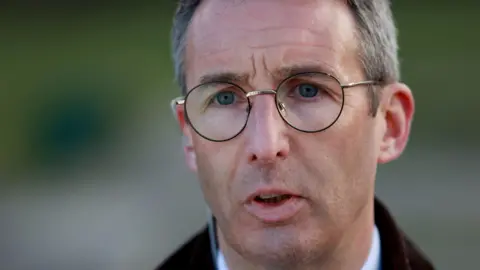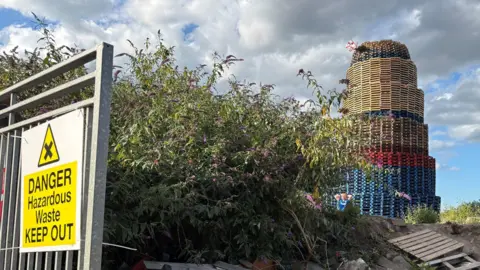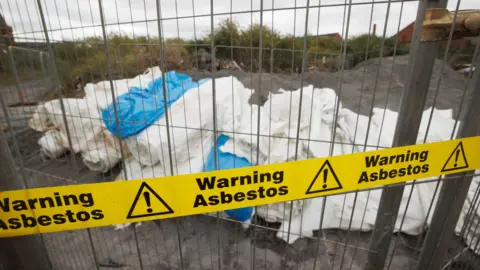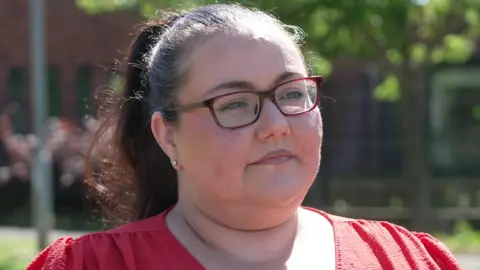Don't light bonfire over asbestos concerns - Muir
 PA Media
PA MediaNorthern Ireland's environment minister has urged people not to light or attend a controversial bonfire in south Belfast on Friday night due to the presence of asbestos on the site.
Andrew Muir has defended the Northern Ireland Environment Agency's (NIEA) handling of removing the material, accusing political opponents of "finger pointing".
Concerns had been raised about asbestos at the site as well as fears over the power supply to two major hospitals because the bonfire is near an electricity substation.
Earlier, the grand secretary of the Orange Order said the bonfire should go ahead, saying concerns about the presence of asbestos on the site were "clearly political".
Eleventh Night bonfires will be lit across Northern Ireland on Friday night to usher in 12 July commemorations.
The Northern Ireland Environment Agency (NIEA) has removed about 20kg of asbestos from the site, between the Donegall Road and the Westlink and has confirmed that further fragments of asbestos have been found at the site.
Speaking for the first time about the matter, Muir, an Alliance Party MLA, said: "There are many ways to celebrate but not at this site.
"Personally I respect how important the 11th and 12th is, I understand its importance but I'd plead with people to exercise caution and not to light this bonfire if they could."
Muir told BBC News NI he was first made aware of the issues at this bonfire site a "number of weeks ago".
 PA Media
PA Media"The removal of asbestos is very complex and delicate, it requires the site to be completely vacated. The site has not been vacated and that's one of the important issues," Muir said.
Asked why his department did not step in sooner, given the NIEA first became aware of the developments in May, he defended the agency's approach and said there had been "detailed engagement" with both the landowner and other agencies to try to mitigate the risks.

Earlier, the grand secretary of the Orange Order, Rev Mervyn Gibson, said if asbestos had been a major issue, environmental agencies should have said so months ago, as bonfire builders had been on site since January.
Mr Gibson told the BBC's Good Morning Ulster Programme that people should "go and enjoy themselves" at the bonfire.
"I think it's clear for everybody that the decision that was made was a political decision. This asbestos has been there from 2017," he said.
"I believe the council voted a couple of weeks ago for the bonfire to go ahead. A few days before it then Sinn Féin and Alliance and the SDLP decide to vote against it."
However, former Progressive Unionist Party (PUP) leader Brian Ervine said the bonfire should not be lit.
Speaking on BBC Radio Ulster's Talkback programme, he said: "It would be preferable if they did not light the bonfire, but if they do light the bonfire then they must be prepared for the consequences that follow for themselves and their people."
He also said that after 12 July, "all the executive and all the agencies have to clear the site and make it safe".
 PA Media
PA MediaHowever, Sinn Féin MLA Pat Sheehan said "serious public safety concerns remain".
"A factual assessment is urgently needed to determine the extent of asbestos on this site and the dangers it presents."
He added that "lessons need to be learned" over how "we ended up in this position".
On Thursday, police confirmed they would not assist in the removal of the bonfire.
They had been asked by the council to assist contractors to dismantle the bonfire before it was lit.
The PSNI said that, after a multi-agency meeting, it was felt "the risk of the bonfire proceeding as planned was lower and more manageable than the intervention of contractors and the proposed methodology of dismantling it".
Belfast City Council voted to write to the environment minister to have the asbestos removed and said it remained concerned about asbestos on the site and would continue to raise concerns with the NIEA.
The NIEA said it was first alerted to the issues around the bonfire on 16 May, but "circumstances did not allow for the safe and controlled removal of the asbestos", prior to the Eleventh.
It said mitigating measures were agreed to reduce the risk to public health.

Bonfires are lit as part of Eleventh night celebrations in some unionist areas of Northern Ireland, to usher in the Twelfth of July, the main date in the parading season.
The Twelfth commemorates the Battle of the Boyne in 1690 when the Protestant King William III - also known as King Billy and William of Orange - defeated Catholic King James II.
Democratic Unionist Party (DUP) councillor Sarah Bunting questioned the NIEA finding more suspected asbestos.
"The sites we were shown where the asbestos has been found, most of them were just around the stockpile of asbestos that has been covered… why was that not found before?"
Bonfire builders have voluntarily removed tiers of pallets from the top of the bonfire and told BBC News NI the action was an "olive branch" to those concerned.
What is risk with asbestos?
Alan Stout, a GP and the chair of the BMA NI Council, said it was "surreal" that people could have been exposed to asbestos at the site.
"If there's asbestos there just don't go there, any other circumstance, environment... be it a school be it a hospital, you rope it off, you secure it and you remove it in a safe manner and... you do not expose your general population to it."
Dr Stout said people should not attend the bonfire and should not be near the site.
He said there is a "20 to 30-year lag" until health issues occur, and said his own east Belfast practice has seen conditions associated with exposure to asbestos.
Dr Stout added that at an event, such as the lighting of a bonfire, a lot of people on the site could "disturb" the asbestos and "that's what causes the harm".
Who owns the site?
The landowners, Boron Developments, bought the site in the summer of 2017 and were made aware of asbestos at that time.
Boron Developments have said it engaged a waste management company to remove the asbestos but the company needed "no personnel" on the site in order to complete the removal of asbestos.
Due to people "bringing in materials and building the bonfire" the company told the landowners it could not complete its work.
The council said while the lands at the site remained "the responsibility of the landowner" the council and the NIEA were "working together in relation to this site".
